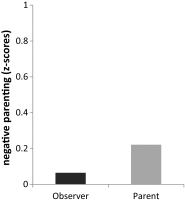In the Eye of the Beholder? Parent-Observer Discrepancies in Parenting and Child Disruptive Behavior Assessments
- PMID: 29294209
- PMCID: PMC6061015
- DOI: 10.1007/s10802-017-0381-7
In the Eye of the Beholder? Parent-Observer Discrepancies in Parenting and Child Disruptive Behavior Assessments
Abstract
This study examined parent-observer discrepancies in assessments of negative child behavior and negative parenting behavior to shed more light on correlates with these discrepancies. Specifically, we hypothesized that informant discrepancy between observers and parents on child behavior would be larger when parents reported high levels of negative parenting (and vice versa) because high levels of these behaviors might be indicators of negative perceiver bias or patterns of family dysfunctioning. Using restricted correlated trait-models, we analyzed cross-sectional observation (coded with the Dyadic Parent-Child Interaction Coding System) and survey data (Eyberg Child Behavior Inventory and Parenting Practices Interview) of 386 Dutch parent-child dyads with children aged 4-8 years (Mage = 6.21, SD = 1.33; 55.30% boys). Small associations between parent-reported and observed child and parenting behavior were found, indicating high discrepancy. In line with our hypothesis, this discrepancy was higher when parents self-reported more negative parenting or more negative child behavior. Parent-observer discrepancy on negative child behavior was also predicted by child gender. For boys parents reported higher levels of negative child behavior than were observed, but for girls parents reported lower levels of negative child behavior than were observed. These findings suggest that informant discrepancies between observers and parents might provide important information on underlying, problematic family functioning and may help to identify those families most in need of help.
Keywords: Childhood; Externalizing problems; Multi-informant discrepancies; Parenting.
Conflict of interest statement
Conflict of Interest
Martine Moens, Joyce Weeland, Danielle Van der Giessen, Rabia Chhangur and Geertjan Overbeek declare that they have no conflict of interest.
Ethical Approval
All procedures performed in studies involving human participants were in accordance with the ethical standards of the institutional and/or national research committee and with the 1964 Helsinki declaration and its later amendments or comparable ethical standards.
Informed Consent
Informed consent was obtained from all individual participants included in the study.
Figures




Similar articles
-
Understanding the nature of associations between family instability, unsupportive parenting, and children's externalizing symptoms.Dev Psychopathol. 2020 Feb;32(1):257-269. doi: 10.1017/S0954579418001736. Dev Psychopathol. 2020. PMID: 30732672 Free PMC article.
-
Interdependence among mothers, fathers, and children from early to middle childhood: Parents' sensitivity and children's externalizing behavior.Dev Psychol. 2018 Aug;54(8):1528-1541. doi: 10.1037/dev0000525. Epub 2018 Jun 21. Dev Psychol. 2018. PMID: 29927264
-
Tele-PCIT: Initial Examination of Internet Delivered PCIT for Young Children with Autism.Child Psychiatry Hum Dev. 2025 Feb;56(1):101-110. doi: 10.1007/s10578-023-01539-4. Epub 2023 May 12. Child Psychiatry Hum Dev. 2025. PMID: 37171780
-
Parenting Stress through the Lens of Different Clinical Groups: a Systematic Review & Meta-Analysis.J Abnorm Child Psychol. 2018 Apr;46(3):449-461. doi: 10.1007/s10802-017-0313-6. J Abnorm Child Psychol. 2018. PMID: 28555335 Free PMC article.
-
Treatment of child externalizing behavior problems: a comprehensive review and meta-meta-analysis on effects of parent-based interventions on parental characteristics.Eur Child Adolesc Psychiatry. 2019 Aug;28(8):1025-1036. doi: 10.1007/s00787-018-1175-3. Epub 2018 Jun 8. Eur Child Adolesc Psychiatry. 2019. PMID: 29948228 Review.
Cited by
-
A Preliminary Evaluation of a Brief Behavioral Parent Training for Challenging Behavior in Autism Spectrum Disorder.J Autism Dev Disord. 2023 Aug;53(8):2964-2974. doi: 10.1007/s10803-022-05493-3. Epub 2022 Apr 30. J Autism Dev Disord. 2023. PMID: 35488976 Free PMC article. Clinical Trial.
-
Differences in developmental problems between victims of different types of child maltreatment.J Public Child Welf. 2022 Feb 24;17(2):408-429. doi: 10.1080/15548732.2022.2044429. eCollection 2023. J Public Child Welf. 2022. PMID: 36896409 Free PMC article.
-
Maternal alcohol dependence symptoms, maternal insensitivity to children's distress, and young children's blunted emotional reactivity.Dev Psychopathol. 2025 May;37(2):555-577. doi: 10.1017/S0954579424000324. Epub 2024 Mar 1. Dev Psychopathol. 2025. PMID: 38426705
-
Behaviour Concerns in Preschool Cardiac Surgery Survivors.CJC Pediatr Congenit Heart Dis. 2024 Apr 26;3(4):141-151. doi: 10.1016/j.cjcpc.2024.04.001. eCollection 2024 Aug. CJC Pediatr Congenit Heart Dis. 2024. PMID: 39493667 Free PMC article.
-
Pathways by which Maternal Factors are Associated With Youth Spina Bifida-Related Responsibility.J Pediatr Psychol. 2020 Jul 1;45(6):610-621. doi: 10.1093/jpepsy/jsaa020. J Pediatr Psychol. 2020. PMID: 32337548 Free PMC article.
References
-
- Abidin RR. The determinants of parenting behavior. Journal of Clinical Child Psychology. 1992;21(4):407–412. doi: 10.1207/s15374424jccp2104_12. - DOI
-
- Abrahamse, M. E., Junger, M., Leijten, P. H., Lindeboom, R., Boer, F., Lindauer, R. J. (2015). Psychometric properties of the Dutch Eyberg Child Behavior Inventory (ECBI) in a community sample and a multi-ethnic clinical sample. Journal of Psychopathology and Behavioral Assessment, 37(4), 679–691. 10.1007/s10862-015-9482-1. - PMC - PubMed
-
- Abrahamse ME, Junger M, Van Wouwe MA, Boer F, Lindauer RJ. Treating child disruptive behavior in high-risk families: A comparative effectiveness trial from a community-based implementation. Journal of Child and Family Studies. 2016;25(5):1605–1622. doi: 10.1007/s10826-015-0322-4. - DOI - PMC - PubMed
-
- Achenbach TM. As others see us: Clinical and research implications of cross-informant correlations for psychopathology. Current Directions in Psychological Science. 2006;15:94–98. doi: 10.1111/j.0963-7214.2006.00414.x. - DOI
Publication types
MeSH terms
LinkOut - more resources
Full Text Sources
Other Literature Sources
Medical

